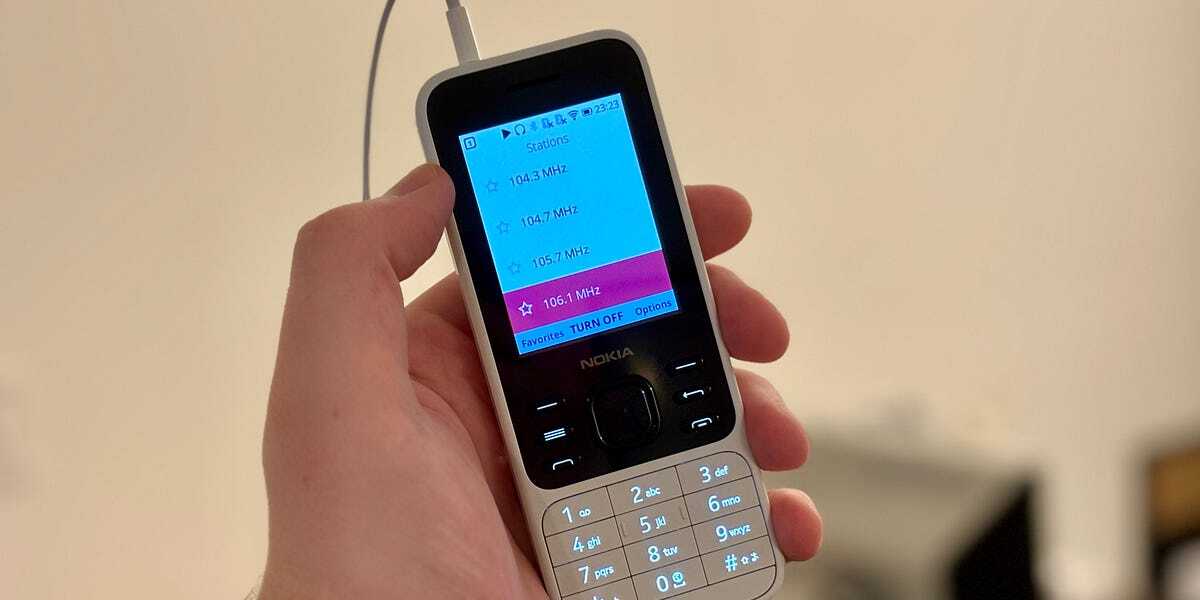- cross-posted to:
- technology@lemmy.world
- cross-posted to:
- technology@lemmy.world
I didn’t even realize Qualcomm removed the built in FM radio from their chips. Huh.
i hate how every quality of life feature now has to be pitched as essential safety, instead of simply being there because it’s good. can’t have quality anymore unless it’s literally necessary
Meh, I haven’t listened to FM in years. It’s just not a feature as far as I’m concerned.
I know I’m a minority opinion but I like having the option. It’s like IR blasters, SD cards, removable batteries… things I didn’t use all the time but sometimes come very much in handy.
Return of the IR blaster would be absolutely killer for me. I LOVED that feature on my old Samsungs, especially because my SO has a tendency to just… leave the remote places
They are still there in some chinese brand phones. I’m not sure it’s mentioned anywhere on the box tho.
All Xiaomi phones have it. I have a Redmi Note 10 which has IR blaster
SD Card is pretty much a necessity for me. I really wish the 1TB cards were more affordable. And when I had a phone with removable battery, I used that too. Instead of a power bank, I had 2 batteries. Instant recharge basically.
The problem is that you have to make the line somewhere. Sure, one small feature is kinda miniscule, but you could easily name dozens, and that starts eating into costs and/or other actually useful features fast.
There’s also the fact that when you have a “swiss army knife” of phones chances are it doesn’t do anything really well.
FM is good in theory, but I stopped listening over a decade ago due to the sheer overwhelming advertising. Sometimes it felt like I’d go half an hour or more without any music to listen to. It’s just not worth it
Maybe the 3.5mm jack and headphones could double as an antenna!
The Samsung Galaxy Note 10 Lite does that. If I’m not mistaken, some budget phones nowadays still do that.
Even if they don’t, as long as there’s a headphone jack, it might be possible to add good FM Radio support with NextRadio/Spirit2. You might need to root your phone, though.
Pretty much every phone used to do that
I think this satire whooshed most everybody who replied.
The last phone I had with FM radio was a Sony Ericsson slider from 2009
There were a few Motorola smartphones that did that actually. It worked quite well tbh.
Most phones did that.

All phones I’ve ever owned did that. The radio app would tell you to plug your earphones.
I had one that didn’t require it. I think Prestigio PAP4044 DUO. It could pick up almost nothing, but almost at least wasn’t nothing.
That’s probably true of all of them. Strictly-speaking, an FM radio with a telescoping antenna can pick things up without extending the antenna, but it’s gonna do a pretty poor job.
Sure, but they usually lock you out in software. For example my phone (Poco X3 Pro) will let you turn on FM radio but not tune without antenna connected. Others usually don’t let you use it at all.
I guess it’s because people kept sending them reports of “FM radio not working”.
Oh, gotcha.
There still are. I bought mine a year and a couple of months ago and it has FM radio and a 3.5 mm jack. And it’s a great phone.
Analogue radio is getting shut down in favor of digital broadcasts, so I doubt this would truly be helpful in many areas.
Aren’t digital radio less reliable than analog FM broadcasts? Would digital broadcasts be as useful during an emergency?
I don’t really know that much about the subject, so I’d like to learn a bit more.
It’s not necessarily clear cut for one being more reliable than the other. FM broadcasts are analog and more likely to be subject to interference (interference will directly impact what you hear, but not as badly as with AM radio) and as the signal falls off it will be harder to hear. Digital radio will be perfectly clear as long as you get a signal, but may become distorted or just cut out if the signal is weak and there are too many errors in the data being received. There will be error correction for digital radio signals, but eventually you won’t be able to receive reliably enough that it will fail. If I had to guess, assuming all of the equipment is working, digital is probably going to be more reliable than analog radio in more conditions and over a longer distance, and it probably needs less bandwidth in general because you could compress the stream.
I’d argue it is still less reliable since the channels are multiplexed. This means a failure of single transmitter takes down all of those channels at once. Secondly, digital radio often uses SFN to save bandwidth and power. This however means that a single misconfigured/malfunctioning transmitter can cause destructive interference in a wider area.
This is happening in my area for a few months now. A new low power DAB+ transmitter was added into the network. I was able to get a poor but still usable signal before, while now the signal is strong, there’s too much interference for the error correction to compensate. Someone on a forum from this area has mentioned the same happening to him after the addition of this transmitter, when trying to tune DAB+ in his car.
But sure, if the technology works, it can be better.
For sure! There’s definitely going to be problems with digital radio when it’s used to cram more channels on the same frequency band or whatever. But the particular implementation of broadcast digital radio aside, if we’re just talking modulation, I would bet on digital modes being able to transmit further more reliably than any analog FM signal.
I know that some of the digital modes like FT8 that hams use can be super effective at making long distance contacts in low noise environments. Of course these are text modes, and not used for voice. I’m not sure whether or not something like FT8 will do better than regular CW in the same conditions, but I wouldn’t be terribly surprised if it could… Being able to do error correction for signals would likely make a huge difference in noisy environments.
In a life or death situation it would be easier to construct an FM transmitter/receiver than a digital counterpart.
AM transmitters / receivers are far easier to construct than FM ones, though. If I was in an emergency situation where I couldn’t communicate with anybody I think I might be able to at least make an AM receiver, even if there aren’t very many components around… But I would need a reference to have any clue how to approach an FM one, and you’d definitely need more components available. Frequency modulation is quite a bit more complicated. If you want to transmit, CW is probably your best hope?
Realistically, though, almost anybody in an emergency situation is doomed if the only thing that would save them is building any kind of radio. It’s not a skill set that most people have… Which I guess is why you might advocate for everybody’s phones to be able to act as FM receivers in case that’s the best way to get an emergency broadcast, because then they would have a device that’s capable of it on hand. You’re probably better off if you have a dedicated emergency radio, especially if you might lose power for an extended period of time, though.
Fair point.
Best part about a simple AM receiver is that it doesn’t need a battery… For emergency situations it’d definitely be best as it’s dead simple to construct, you can boost gain in radio station for more reach / power to the battery-less receivers, etc. and the transmitters are simple, too.
For emergencies it’s also not a bad idea to have an offline copy of Wikipedia.
Kiwix is great and Wikipedia is surprisingly small :).
Where?
Norway has been like this for many years now.
I think in the US.
Not in the US.
https://en.wikipedia.org/wiki/HD_Radio
A 400 kHz wide channel is required for HD FM analog-digital hybrid transmission, making its adoption problematic outside of North America. In the United States, FM channels are spaced 200 kHz apart as opposed to 100 kHz elsewhere. Furthermore, long-standing FCC licensing practice, dating from when receivers had poor adjacent-channel selectivity, assigns stations in geographically overlapping or adjacent coverage areas to channels separated by (at least) 400 kHz. Thus most stations can transmit carefully designed digital signals on their adjacent channels without interfering with other local stations, and usually without co-channel interference with distant stations on those channels.[7] Outside the U.S., the heavier spectral loading of the FM broadcast band makes IBoC systems like HD Radio less practical.
The FCC has not indicated any intent to end analog radio broadcasting as it did with analog television,[2] since it would not result in the recovery of any radio spectrum rights which could be sold. Thus, there is no deadline by which consumers must buy an HD receiver.
Maybe some other place.
EDIT: Some countries in Europe apparently have, and some are scheduled to do so in the future.
https://www.radioworld.com/news-and-business/switching-off-fm-in-norway-and-soon-switzerland
This has Norway having killed FM in 2017, and Switzerland scheduled for 2024.
My bad, I was wrong.
That’s news to me, and the cd/fm/am radio at work.
Germany barely has FM anymore - it’s due to be shut off in the next few years.
Phones should have FM radio not as an emergency feature, but as a method of banging out the tunes. I wanna jam out at a campsite with no downloaded music and no cell service.
We’re taking a FM radio there ; )
I don’t own an FM radio small enough to shove up my ass, which a phone with FM would solve. I’m sure phone designers will realize their untapped market soon enough.
That’s…that’s not where radios go…or phones for that matter…
Then why do phones vibrate
Checkmate atheists
Fine… Angryupvote
We all have our own lifehacks.
Don’t judge or you’ll be judged too.
Removed by mod
I don’t own an FM radio small enough to shove up my ass, which a phone with FM would solve.
There are FM radios smaller and more phallic than there are cell phones. You might not own them, but that’s not a problem specific to the radio; clearly your existing cell phone doesn’t do FM or you wouldn’t be running into this problem in the first place.
Finally, a product for the Everyman. Thank you.
The chances of getting FM reception at this campsite aren’t good.
A man can dream, though. A man can dream.
bro are you 12 AM… wait we arent talking about AM?
my phone has an fm radio but it needs wired headphones
That’s because the FM signal needs an antenna that’s longer than you can fit in your phone
Good luck bringing it back when the whole industry moves away from wired headphones and 3.5mm jacks.
industry moves away
And nobody asked them to.
Greed did
I like 1/8" jacks too, but active noise cancellation – which is pretty impressive, honestly – legitimately needed a source of power, and there was no standard way of providing that over that interface.
You can get both USB-C or Bluetooth adapters for a 1/8" headphone set to run an existing pair. I’ll concede that it’s a bit more bulk to carry, but one can continue to use 1/8" headphones with phones.
Wired active noise cancelation headphones exist, you know. They have batteries, which are a perfectly legitimate source of power.
Yeah, I have a pair (which charges over USB-C and also has a 1/8" audio jack). But if you’re having to charge batteries, you’re at the point that you are having to plug it into USB-C anyway, so you might as well just be using USB-C (well, or wireless), since you’re having to deal with the batteries of wireless and plugging into USB anyway. There just isn’t a lot of point to using the 1/8" jack on them other than to let you conveniently also use them with audio sources that have 1/8" jacks but no USB-C/wireless support. It doesn’t really buy you much to use the 1/8" jack on a smartphone that doesn’t have that limitation.
There are some people who have expensive headphones that don’t do ANC and will want to keep using them, but those you can use the adapters on.
cheap Samsungs exist
THATS WHY? i was always confused why that was the case. i thought it was a ““feature”” to only enable fm for headphones. my old phone also only allowed the eq to be used with a speaker other than the internal one
Probably had 2 audio chips and 1 for the speaker and one for the 3.5mm jack, with only one having EQ capabilities
ohh.
Nokia 105 (2023) has a radio that works without headphones so this is not necessarily true.
I had an old Moto phone with an FM radio that worked without headphones, although it was stated that with headphones plugged in reception would be much better (which was true). My current phone (a Moto one too) has FM radio, and I use it.
I never had a phone without FM radio. It’s one of the features I actually want in my phone.
The redmi 7a smartphone I had also supported wireless FM radio without plugging in a headphone jack.
deleted by creator
Ah, the elusive “C o u r a g e” port.
Is this the latest “sneaky” way to insist all phones need headphone jacks?
Because from an emergency standpoint: Most (all?) cars still have analog radios and it is generally encouraged to have a “weather radio” in any emergency kit. Hell, many building emergency kits will have one (even if it is just the shitty radio the rent a cop uses to listen to The Game in the booth). And in the event of a disaster, you really do want to group up. If only because it makes you an easier target for satellites and rescue flights.
So, from an emergency preparedness perspective, this seems like an incredibly niche situation where people are completely isolated, don’t have a car, but still need to tune in to an emergency radio broadcast to figure out where to go and it is not “go to the nearest population center that is not a smoldering wreck”.
all phones do need headphone jacks though
Best we can do is a fancy pen for all that art that people do on their phones all the time
Is this the latest “sneaky” way to insist all phones need headphone jacks?
My current phone has an FM radio, and no headphone jack. It uses the headphones as antenna via the USB-C adapter.
Never used it, though - and rarely used radio in any phone which had that feature before that.
Actually many modern electric cars are trying to get rid of FM radios because the electric motors can cause all sorts of interference (or so they say)
IIRC that’s just an issue with AM radios. And it happens with petrol cars too. A friend of mine’s car has this weird quirk where, while running below 50km/h, (I assume) the alternator generates RF interference in the AM band.
We have nothing broadcasting there though, so no biggie.
The vast majority of vehicles on the road still have them so, again, unless you are truly in the middle of nowhere you can generally flag someone down while you watch Clover be a metaphor for 9-11 and remember “oh yeah, Lizzy Caplan was in this”
And as cars move away from AM/FM: Then we have alternate emergency solutions. Which, again, weather radio in the emergency bag that you just leave in your trunk until you sell the car. And we work to improve the coverage and resilience of emergency broadcasts that phones pick up (speaking of…).
Which gets back to all of this being a “sneaky” way to insist phones need headphone jacks. Since you need an antenna for FM and that is usually a speaker wire. Which… is extra useless and increasingly dangerous if you are trying to hold up your earbuds (because we all still have wired earbuds…) while driving through The Mist.
… which also highlights why a phone is a bad emergency radio. Since plugging in earbuds will generally cut off the phone speakers. But you also need to hold up the earbuds to get enough reception to get a signal. Or you are driving with earbuds in which lowers your awareness during an emergency.
Again, emergency/weather radios. They are cheap, a lot of them have backup hand cranks, and you can just put it in the roadside emergency bag right next to the electric flares/beacons that are basically one time use because, if you pull that tab, the batteries WILL have corroded ten years later when you need them again.
right next to the electric flares/beacons
In the US, you can get magnesium road flares. IIRC, some places in Europe don’t permit them due to fire risk, but in the States, I can get them even in California (which is probably about the most fire-conscious state out there).
Not sure what the current best guidance is but: Please do not use “real” flares unless you have no other choice.
First and foremost: They are horrible for night vision of you and everyone around you. It is basically like you are blasting your headlights into the eyes of EVERYONE who goes near that stretch of road.
Also, a lot of people don’t know how to properly extinguish them. Which results in random ass flares left burning or a hesitance to use them at all.
And cost/space wise? They are horrible. Quick check of amazon says three flares are about 30 bucks. 3 LED flares are about 20. And the road flares are meant to last 15-30 minutes (your mileage may vary). The LEDs last until you turn them off because they are LEDs.
Cops love them because cops are raging assholes who want to make everyone else understand they are doing cop things in the vicinity.
But as a driver? You are better off with the LED flares in basically every single situation.
And, as an aside: Driving back from the airport usually involves going past a stretch of interstate where it seems people can’t NOT explode tires on a daily basis. And it is not an exaggeration to say that random ass flares burning in the middle of the road or in the ditch between directions is a nightly occurrence.
You’re entitled to use electric flares if you want, but I will use the chemical ones.
First, I would point out that my comment is in response to your comment pointing out that electric flares may-or-may-not have a charged battery.
Second, magnesium flares have much-better visibility.
As for life, you can get longer ones, and use as many as you want; I carry three extended-size ones.
I also have a flasher on something like a 400 Wh, large lithium battery that I keep in the car, but I’m not going to rely on that to have someone not slam into me in the fog.
No. It was more a statement that the LED flares are basically one use only… unless you are spending every night on the side of the road. Their shelf life is more or less the same as a chemical flare in that case.
As for “improved visibility”: The goal of a flare is not to make everyone see you and to let you see what you are doing. The goal is to say “Hey, something is over here. Be careful”.
But also: You do realize that your tail lights/brake lights are more or less the exact same LEDs, right? So unless you duct tape flares to your car and roll around Fury Road style, I think you are fine there. Even on a foggy day.
Which gets to the other aspect: “Visibility” is bad when it is extremely bright lights at night. There is a reason that headlights (you know, those things people ignore in favor of the high beams) aren’t actually insanely bright. They are bright enough and angled enough that you can see where you are going. You pulse your high beams if the way is clear to see farther. If the way is not clear? Then the other headlights on the road provide extended visibility.
And… I am not sure if you have ever had to drive on a country/mountain road with asshole trucks with the high beams on. But it more or less renders you blind for a few seconds until they pass and you just have to rely on maintaining your lane. And if there is a curve? You either risk a header or you slow down and let them by first.
Which is why, as nice as it sounds to have a daylight flare right next to your car on the side of the road, it actually greatly increases the danger to you. Same reason you never use high beams in the fog (even though people do…) and actual fog lights are angled very differently.
As for “improved visibility”: The goal of a flare is not to make everyone see you and to let you see what you are doing. The goal is to say “Hey, something is over here. Be careful”.
Right. For which visibility is important.
You do realize that your tail lights/brake lights are more or less the exact same LEDs, right?
Yup. Which people proceed to slam into in those many-car pileups in the fog when they can’t see far-enough away that something is wrong despite people having their hazard blinkers on, and nicely illustrates why you would want to have magnesium flares.
That’s bullshit.
Ride around in a golf cart listening to the radio sometime. It works fine.
Part of the reason the manufacturers want to get rid of the radios is because they make the entertainment center style consoles that all cars have now much more expensive.
For most people, the best radio they own is the one in their car. Radios near interference sources like rotating iron parts need to be well shielded and a lot of the design techniques that will accommodate high selectivity and sensitivity are shared with interference tolerance.
So even the shittiest car had to have a decent radio.
Nowadays the shittiest car could have a godawful quality infotainment system if it weren’t for the damn radio that buyers expect. And it’s not like the manufacturers can just slap down a trash radio into the infotainment system, it would require shielding, separation and a host of other components and techniques that are just left off crappier digital electronics all together.
Since so many other countries have sunset analog fm, theres readily available cheap shitty infotainment systems for use in the rios and versas that make up the majority of car sales in the us and have razor thin profit margins.
So… no, the electric motors aren’t keeping them from putting a radio in electric cars.
E: but if you don’t wanna believe gayhitler420s rant about radio, plenty of electric cars have am/fm radios in em, including the Toyota bz4x.
Right now the iPhone can straight up connect to the Iridium Satellite network, which IMO is far more useful that FM radio in any emergency. At least that system can send and receive messages, including most importantly GPS Co-ordinates.
While not a physical radio, a Linux phone such as the Librem 5 in conjunction with an RTL-SDR dongle and external antenna may be a good candidate for a mobile software-defined radio (SDR) transceiver.
SDR frameworks such as GNUradio or REDHAWK are well-established by this point. Newer versions of REDHAWK are designed to run on CentOS/Rocky Linux, however, and they don’t (AFAIK) come with a mobile-friendly UI.
I do know that there are some web-based SDR tools in the wild. I’m not very familiar with them, their system requirements/capabilities/limitations, but they could be worth a look to jump-start a Progressive Web App for mobile devices.
SDR is neat but will be awfully power-inefficient, and if one is thinking of an emergency situation where one has to receive information and even the cell system is down, I would wager that being concerned about power usage on a cell phone is probably also going to be a factor.
My sister and some friends once were out in the forest and managed to get get themselves lost, out of sight of civilization but within cell range. The very first thing that the sheriff told them to do was to turn off all but one cell phone that they had with them, to maximize their battery lifetime. I suspect that that’s probably standard advice from law enforcement, and the situation there was a lot-less of a major emergency than a loss of the cell network would be.
GPS works anywhere on earth and doesn’t require a cell connection, it even works in airplane mode, so you really can’t get lost if you have the maps app (which you probably do)
IF you have the local maps downloaded.
Mapping apps like Magic Earth are a lot faster than Google Maps, especially when outside good cell coverage, and it’s easy to download maps in advance for wherever you’re going to be.
Yeah, this was years back when people were running around with candy bar phones. I’m not saying “you need this to deal with getting lost”, but rather just that running out of power is a concern.
Or basically any Android with OTG support. There’s a bunch of SDR software also available on Android. SDR++, SatDump, SDRAngel, Welle.io, Dump1090,…
But obviously, a proper GNU+Linux phone will do better.
you can listen to encrypted radio transmissions this way with the correct codes and software of course
stop sharing police technology bro /,$
I keep a small solar/crank generator/USB-powered radio in my car. Which can provide USB power, act as a light, and also, in a pinch, charge my cellphone. You can get these starting at about $13 on Amazon.
That’s not quite as good as having one with everyone, but as long as you’re within walking distance of your car, you can probably get to it. It also has some benefits:
-
More power-friendly than a cell phone.
-
At least a portion of the kinds of things that might take out the cell infrastructure (e.g. cyberwarfare targeting the cell system) may also take out phones themselves, like if someone can push bad updates out to the phones. Your dead-simple FM radio isn’t going to have problems unless actual FM radio broadcasters get knocked out. If you’re in the US, there is very little real opportunity for someone to conduct a significant, conventional attack on the country, but being able to find holes in the Internet-connected infrastructure and do damage there has a lot more unknowns and the ability of various parties to disable or destroy it is much more of a possibility. Militaries do build up collections of holes to hit adversaries with. One of the first things Russia did when invading Ukraine was to knock out Viasat infrastructure, using a hole that they’d discovered in that company’s network, to degrade communications in Ukraine by pushing out an update to brick satellite modems. I also remember some guy at a think tank in the US that covers cyberwarfare saying that one of the surprises was that Russia didn’t try to disable Ukraine’s cell network, either via cyberwarfare or via conventional means; taking out the cell network would do a lot to dick up a country.
I got one after the crazy storms we had over the summer. Had an old cube Nola radio that ran on a 9volt we had growing up but that has long since been lost
I saw a YouTube video where someone was testing crank powered phone chargers and they weren’t able to get enough juice to ever power the phones. Have you tested it for that purpose?
It charges a battery in the radio, and then that discharges while charging other devices. Now, you may be spending an unpleasantly-long amount of time cranking the thing, but that’s another matter.
With respect, I’d like to double down on my question and ask if you personally have used it to charge your phone and how well it worked.
I haven’t used it to charge the phone. I normally carry a number of other devices that provide charge, including a larger set of folding solar panels and another battery bank, in the car, and I’ve used that, but not this particular solar/crank charger.
I would be legitimately interested in a demonstratably good crank charger, but it seems like there’s a million bad ones out there, that’s why I ask.
When you see how little energy a Tour d’France cyclist can generate, with their legs, over a given period of time, it becomes clear why these crank things are useless.
You could possibly charge a phone with a cycling setup, I haven’t done the math in a while. What I recall is the human body makes for a terrible generator.
Humans are efficient, and there are also huge losses in converting the energy from work to electricity, and then further converting this to whatever voltage you actually need, while also likely first charging a battery somewhere so you can use it at a different time than you are cranking/pedaling…
However humans are also strong and can think of mechanisms that help with leverage and whatnot; for example an elliptical machine would probably be better than a bike.
With that being said the power you can generate is still pretty small; around 100Wh is floating around. If you worked out more you’d make more, obviously, but that might not be feasible.
It’d still be more than enough for essentials like charging your phone though.
Fair enough, good point.
Fair enough. I’m not too worried about it charging (though I am confident that it will be an enormous amount of work and possibly take multiple passes while leaving the cell phone off). For me, this was more a “throw one more backup layer” on things; when I’m in the car and carrying what I normally lug around, I typically have:
-
The ~100Wh car battery and USB adapter off the cigarette lighter.
-
A tank of fuel to charge said battery.
-
A car jump starter (in case said battery goes dead), with its own battery that can do USB.
-
A laptop with its own battery with USB output.
-
A tablet with its own battery with USB output
-
A small power station.
-
A second, 100Wh power station.
-
A ~400Wh large power station.
-
An unfolding set of solar panels with another small power station.
-
The aforementioned solar/crank charger with a very small power station.
Having to actually crank anything is going to be about at the bottom of the list in terms of things that I’m going to be doing in any situation, so this is about 9 things that would have to fail subsequent to my cell phone battery dying in a situation where there’s an emergency for this to come up.
I did consider a more-serious charger at one point, but that would have been a pedal power station; it’s vastly easier to generate a given amount of electricity with your legs than your arms. If having it in the car or house is all you need, that’s probably a better choice if you’re worried about it (and you can definitely find video on YouTube of people charging phones with it):
https://www.k-tor.com/shop/generators/power-box/
There’s also someone that sells a tiny thermoelectric camping generator that can run on wood. If you’re really concerned about needing power, my guess is that it’s probably less-work to find something you can burn in that.
googles for the name
“BioLite”
https://www.amazon.com/BioLite-Campstove-Electricity-Generating-Charging/dp/B00FU8RBPE/
EDIT: I also have an AA-battery-to-USB-and-USB-to-AA-battery powerstation somewhere, but I don’t know if that’s actually in the car. I think that that’s at the house.
-
You keep it in your car, I’m sure your car can charge your phone.
Arent you supposed to crank charge a battery for a while, and then charge the phone or other device via the battery? Or do you mean they couldnt meaningfully charge the battery at all
The ladder, they weren’t able to get anything meaningful from a pretty great deal of effort into cranking it.
That’s what you get when trying to charge a phone with a ladder!
But what if it’s a Smart Ladder™?
I also remember some guy at a think tank in the US that covers cyberwarfare saying that one of the surprises was that Russia didn’t try to disable Ukraine’s cell network, either via cyberwarfare or via conventional means; taking out the cell network would do a lot to dick up a country.
Russia didn’t disable the cell network because they were using cell phones to coordinate their forces (as presumably they didn’t have proper radios).
Yeah. It’s not like Russia isn’t into dicking up Ukraine.
Russia doesn’t want ukraine or its people: Russia just wants what it probably calls ‘western Russian’ Farmland; and some poor people to work it.
signal fires it is then
-
Some phone today do have that. Service providers like to disable the feature though
My last couple of phones have definitely had it (Motorola).
There’s another type of radio that could save lives if implemented in smartphones. In the United States, the NOAA runs a network of radio towers that broadcast up-to-the-minute weather reports and automated alerts, which are specifically designed to stay running during tornadoes and other emergencies. The signals are broadcasted on 162.400 – 162.550 MHz, above the FM band, allowing the signals to travel much farther than regular radio or cell networks.
Higher frequencies travel shorter distances and permeate through buildings and trees less, so 162.4 - 162.55 MHz is going to be worse than the rest of the FM band (but still better than cell frequencies).
It’s not that straight forward. And in a practical sense 162MHz is hardly significantly higher than 100MHz.
Apologies, I accidentally missed off the end of the quote, the bit I was commenting on:
The signals are broadcasted on 162.400 – 162.550 MHz, above the FM band, allowing the signals to travel much farther than regular radio or cell networks.
I agree that it isn’t much different. However it is objectively worse than regular FM radio, not better as the article claimed.
I still disagree. There are far more significant factors than the frequency.
Longer wavelength isn’t an instant blanket solution to better propogation.
Factors like typical transmitter and receiver configurations matter, location matters, object density matters, reflections etc… etc…
Hence why UHF is preferred in some cases by emergency services and so on.
Ultimately anything above 60MHz is going to be line of sight or a reflection when assuming the receiving station is mobile or portable, and in that case if the user is indoors higher frequencies might reflect better.
Also narrow FM has more power density than wide FM for the same power level, hence why broadcast transmitters need to be so incredibly powerful to get anywhere.
They would have to put the headphone jacks back in since the wires were the antenna
Secret real benefit discovered!
When my phone dies it will be hard to pick a replacement. The 3.5mm jack is a core feature.
Zenfone maybe?
they should have never removed it in the first place.
… my last phone had fm radio that didn’t need headphones to work or even internet. My new phone needs headphones to work… why are y’all buying expensive phones with no features!!!
No headphone socket on all the cool phones now, remember?
So now the manufacturer needs to squeeze a FM antenna into the phone and they juuuust used “lack of space” as the bullshit excuse for removing the headphone socket on this new model so they’d much prefer to pretend that FM radio didn’t exist thanks.
Germany got it removed for more than 6 years ago. My last capable phone was the Samsung S3.
I’d say AM radio is a better safety feature for Australians at least, since the ABC broadcast emergency warnings via their AM stations.























